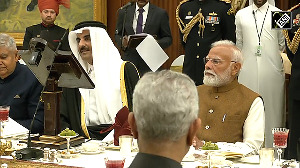We shouldn't be surprised. By throwing the door wide open to foreign investors, the new policy offers a very real chance, for the first time in ages, to rebuild this ancient land with icons of a new age.
But are we ready in our mind for an architectural transformation of India, one that will tune us in to the rest of the world and not perpetuate our reputation as a repository of ill-conceived, pseudo-classical monstrosities?
The question is justified. Dead habit seems to have rendered us incapable of thinking originally, and somehow our "new" always takes the appearance of our "old."
In fact, Bengal Peerless' published design of its proposed "Axis" multi-utility complex in Rajarhat New Town on Kolkata's eastern fringe once again proves that the threat to our cities from "mindless" builders continues to be very real.
What do we have here? A part-Ashoka-Hotel-part-General-Post-Office-(Kolkata) hotchpotch that could pass either as a government secretariat or a museum or an 18th century royal palace, but actually looks little more than a sprawling (supposed to be 84,000 sq ft), monotonous, and haphazard pile of concrete.
The sense one gets is that of closed-in space, like a tomb. The uniform wash of white paint applied to the model reinforces the feeling.
Yet, not too far from the site of the proposed development, in neighbouring Salt Lake, we have a City Centre that stands as a shining example of how beautiful an urban space can be made to look.
This Charles Correa creation would lend pride to any city anywhere in the world and has a heart that never ceases to throb through a clever fusion of public and commercial spaces.
The design is open, friendly, inviting, and never tiresome on the eye.
Why can't we have more Charles Correas and Balkrishna Doshis in India? Why don't we listen to what these masters have to say and learn from their examples?
Why do we always have to regurgitate our past -- Hindu, Mughal or British colonial -- and create more buildings in the same tradition? Don't we have more than enough of them already, smothering our senses with a boring repetition of styles and robbing the land of novelty and wonder?
India needs to get out of this mould. At the same time, it must get rid of its PWD mindset, which has filled our cities with some of the dullest and most awful buildings one can find anywhere.
Let's not ruin them any further. We need beautiful forms and spaces aesthetically divided and integrated to create beautiful surroundings. We need new ideas to lend our landscape visual excitement, ideas that foreign developers could bring us and help us rediscover our own creativity.
Other countries in Asia have used foreign architects and ideas to improve their physical looks. Australian designers had much to do with Malaysia's picture-perfect greening.
Singapore's glitz has been conjured by some of the world's best-known architects from Europe and America, including the legendary I M Pei. The Philippines borrowed American ideas to develop Asia's first truly modern urban commercial centre, Makati, and later to transform a neighbouring army base, Fort Bonifacio, into a global city.
Britain's Norman Foster set off an architectural sensation in Hong Kong -- the Hongkong Bank headquarters -- that later spread to the mainland of China, where scores of foreign architects from all over the world are currently at work to change the face of this once tradition-bound country in an amazing sweep of post-modernism.
Why can't India boast an I M Pei or a Norman Foster, a Frank Gehry or a Zaha Hadid, masterpieces that people from other countries would be tempted to come and look at, like they go to Malaysia to admire the Twin Towers? Surely, we are rich enough to afford one and big enough to deserve it.
Only, we have to open up our mind and think big, think bold, and think new. Let's not be persuaded by false nationalism, because world architecture is no longer pure American or pure British.
Today's master architects speak a language that's truly universal, expressed as pure form and space.
I know it's difficult for us to accept pure beauty. Years of PWD culture seem to have killed our sense of aesthetic space. Buildings are nothing but four walls and doors and windows.
Space is meant to be closed up and filled, if not with brick and mortar, then with rubble, scrap metal, garbage, hawkers' stalls, or jhopris.
Still, there's no harm in hoping that even we can have better sense. Sometimes.








 © 2025
© 2025